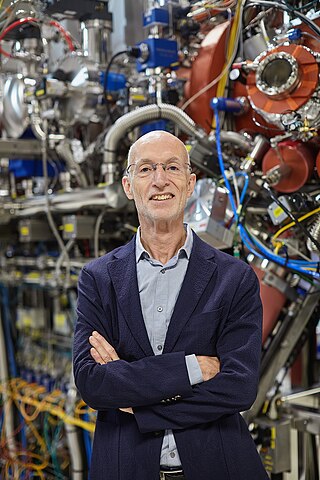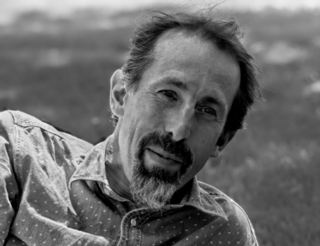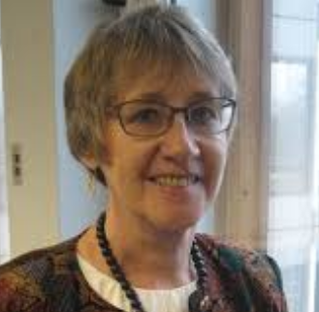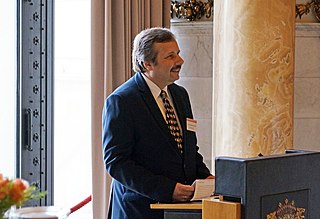
Sir Joseph John Thomson was a British physicist and Nobel Laureate in Physics, credited with the discovery of the electron, the first subatomic particle to be found.

Louis Eugène Félix Néel was a French physicist born in Lyon who received the Nobel Prize for Physics in 1970 for his studies of the magnetic properties of solids.

Sir Michael Victor Berry, is a British mathematical physicist at the University of Bristol, England.

Klaus von Klitzing is a German physicist, known for discovery of the integer quantum Hall effect, for which he was awarded the 1985 Nobel Prize in Physics.

Albert Fert is a French physicist and one of the discoverers of giant magnetoresistance which brought about a breakthrough in gigabyte hard disks. Currently, he is an emeritus professor at Paris-Saclay University in Orsay, scientific director of a joint laboratory between the Centre national de la recherche scientifique and Thales Group, and adjunct professor at Michigan State University. He was awarded the 2007 Nobel Prize in Physics together with Peter Grünberg.

Victor Georgievich Veselago was a Soviet Russian physicist, doctor of physical and mathematical sciences, and a university professor. In 1967, he was the first to publish a theoretical analysis of materials with negative permittivity, ε, and permeability, μ.
Denis Lawrence Weaire FRS is an Irish physicist and an emeritus professor of Trinity College Dublin (TCD).

Stuart Stephen Papworth Parkin is an experimental physicist, Managing Director at the Max Planck Institute of Microstructure Physics in Halle and an Alexander von Humboldt Professor at the Institute of Physics of the Martin-Luther-University Halle-Wittenberg.

In physics, amorphous magnet refers to a magnet made from amorphous solids. Below a certain temperature, these magnets present permanent magnetic phases produced by randomly located magnetic moments. Three common types of amorphous magnetic phases are asperomagnetism, speromagnetism and sperimagnetism, which correspond to ferromagnetism, antiferromagnetism and ferrimagnetism, respectively, of crystalline solids. Spin glass models can present these amorphous types of magnetism. Due to random frustration, amorphous magnets possess many nearly degenerate ground states.

The Max Born Medal and Prize is a scientific prize awarded yearly by the German Physical Society (DPG) and the British Institute of Physics (IOP) in memory of the German physicist Max Born, who was a German-Jewish physicist, instrumental in the development of quantum mechanics. It was established in 1972, and first awarded in 1973.
The Nevill Mott Medal and Prize is an award presented in selected years by the Institute of Physics in the United Kingdom, for distinguished research in condensed matter or materials physics. It was first established in 1997 thanks to a donation from Sir Nevill Mott's family. Sir Nevill Mott was one of the outstanding British condensed matter theorists and won a Nobel Prize in Physics in 1977. He died in 1996. The award consists of a silver medal and a prize of £1000.

Erasmus Smith's Professor of Natural and Experimental Philosophy at Trinity College Dublin is a chair in physics founded in 1724 and funded by the Erasmus Smith Trust, which was established by Erasmus Smith, a wealthy London merchant, who lived from 1611 to 1691. It is one of the oldest dedicated chairs of physics in Britain and Ireland. Originally, the holder was to be elected from the members of the college by an examination to determine the person best qualified for the professorship. Since 1851, the professorship has been supported by Trinity College. Of the 22 holders of this chair, seven were Fellows of the Royal Society while one, Ernest Walton, won the Nobel Prize for Physics.

Jeremy John Baumberg, is a British physicist who is Professor of Nanoscience in the Cavendish Laboratory at the University of Cambridge, a Fellow of Jesus College, Cambridge and Director of the NanoPhotonics Centre.
Echur Varadadesikan Sampathkumaran is an Indian condensed matter physicist and a Distinguished Professor at the Tata Institute of Fundamental Research. Known for his research on the thermal and transport behaviour of magnetic systems, Sampathkumaran is an elected fellow of all the three major Indian science academies viz. Indian Academy of Sciences, Indian National Science Academy and National Academy of Sciences, India as well as The World Academy of Sciences. The Council of Scientific and Industrial Research, the apex agency of the Government of India for scientific research, awarded him the Shanti Swarup Bhatnagar Prize for Science and Technology, one of the highest Indian science awards, for his contributions to physical sciences in 1999.

Andreas J. Heinrich is a physicist working with scanning tunneling microscopy, quantum technology, nanoscience, spin excitation spectroscopy, and precise atom manipulation. He worked for IBM Research in Almaden for 18 years, during which time he developed nanosecond scanning tunneling microscopy which provided an improvement in time resolution of 100,000 times, and combined x-ray absorption spectroscopy with spin excitation spectroscopy. In 2015 his team combined STM with electron spin resonance, which enables single-atom measurements on spins with nano-electronvolt precision REF1, REF2. In 2022 his team demonstrated the extension of ESR-STM to individual molecules REF3. Heinrich was also principal investigator of the stop-motion animated short film A Boy and His Atom filmed by moving thousands of individual atoms. He is a fellow of the American Physical Society and the American Association for the Advancement of Science and the recipient of the Heinrich Rohrer Medal of the Japan Society of Vacuum and Surface Science.

Ursula "Uschi" Steigenberger FInstP was a German condensed matter physicist and director of the ISIS neutron source. She was one of the founders of the Institute of Physics Juno Award.

Dmitry Dmitriyevich Mishin was a Soviet and Russian physicist, Doctor (habilitate) of physical and mathematical sciences, professor, founder of the scientific school of magnetic scienсе in Tver State University.

Roland Wiesendanger is a German physicist, specializing in nanoscience. Since 1993 he has been a full professor at the University of Hamburg, Germany.

Laura Henderson Lewis is an American electronic materials scientist and engineer. She is a distinguished university professor at Northeastern University, having previously served as the department chair of Northeastern University's chemical engineering department. Prior to her Northeastern University position, she was a research group leader and associate department chair in the nanoscience department of Brookhaven National Laboratory (BNL).
Vladimir Petrovich Mineev is a Russian theoretical physicist, specializing in condensed matter physics.















